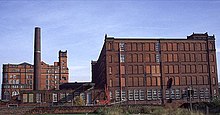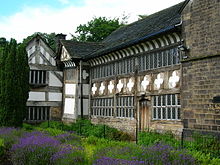Travel to Bolton Map
Bolton tourist guide map of landmarks & destinations by Walkfo
80
travel
spots
![]() When travelling to Bolton, Walkfo’s has created a travel guide & Bolton overview of Bolton’s hotels & accommodation, Bolton’s weather through the seasons & travel destinations / landmarks in Bolton. Experience a unique Bolton when you travel with Walkfo as your tour guide to Bolton map.
When travelling to Bolton, Walkfo’s has created a travel guide & Bolton overview of Bolton’s hotels & accommodation, Bolton’s weather through the seasons & travel destinations / landmarks in Bolton. Experience a unique Bolton when you travel with Walkfo as your tour guide to Bolton map.
Bolton history
Toponymy
Bolton is a common Northern English name derived from Old English bothl-tun . The first recorded use of the name, in the form Boelton, dates from 1185 to describe Bolton le Moors . The town’s motto of Supera Moras means “overcome difficulties”
Early history to the Civil War
There is evidence of human existence on the moors around Bolton since the early part of the Bronze Age . Romans built roads from Manchester to Ribchester to the east and a road along what is now the A6 to the west . It is claimed that Agricola built a fort at Blackrod by clearing land above the forest .
Industrial revolution onward

A tradition of cottage spinning and weaving and improvements to spinning technology by local inventors, Richard Arkwright and Samuel Crompton, led to rapid growth of the textile industry in the 19th century. Crompton, whilst living at Hall i’ th’ Wood, invented the spinning mule in 1779. Streams draining the surrounding moorland into the River Croal provided the water necessary for the bleach works that were a feature of this area. Bleaching using chlorine was introduced in the 1790s by the Ainsworths at Halliwell Bleachworks. Bolton and the surrounding villages had more than thirty bleachworks including the Lever Bank Bleach Works in the Irwell Valley. The mule revolutionised cotton spinning by combining the roller drafting of Arkwright’s water frame with the carriage drafting and spindle tip twisting of James Hargreaves’s spinning jenny, producing a high quality yarn. Self-acting mules were used in Bolton mills until the 1960s producing fine yarn. The earliest mills were situated by the streams and river as at Barrow Bridge, but steam power led to the construction of the large multi-storey mills and their chimneys that dominated Bolton’s skyline, some of which survive today. Growth of the textile industry was assisted by the availability of coal in the area. By 1896 John Fletcher had coal mines at Ladyshore in Little Lever; The Earl of Bradford had a coal mine at Great Lever; the Darcy Lever Coal Company had mines at Darcy Lever and there were coal mines at Tonge, Breightmet, Deane and Doffcocker. Some of these pits were close to the Manchester Bolton & Bury Canal providing the owners with markets in Bolton and Manchester. Coal mining declined in the 20th century. Important transport links contributed to the growth of the town and the textile industry; the Manchester Bolton & Bury Canal constructed in 1791, connected the town to Bury and Manchester providing transport for coal and other basic materials. The Bolton and Leigh Railway, the oldest in Lancashire, opened to goods traffic in 1828 and Great Moor Street station opened to passengers in 1831. The railway initially connected Bolton to the Leeds and Liverpool Canal in Leigh, an important link with the port of Liverpool for the import of raw cotton from America, but was extended in 1829 to link up with the Manchester to Liverpool Line. Local firms built locomotives for the railway, in 1830 “Union” was built by Rothwell, Hick and Company and two locomotives, “Salamander” and “Veteran” were built by Crook and Dean. Bolton’s first Mayor, Charles James Darbishire was sympathetic to Chartism and a supporter of the Anti-Corn Law League. In August 1839 Bolton was besieged by Chartist rioters and the Riot Act was read and special constables sworn in. The mayor accompanied soldiers called to rescue special constables at Little Bolton Town Hall, which was besieged by a mob, and the incident ended without bloodshed. Derby Barracks was established in Fletcher Street in the early 1860s. One of two statues prominent on Victoria Square near Bolton Town Hall is that of Samuel Taylor Chadwick (1809 – 3 May 1876) a philanthropist who donated funds to Bolton Hospital to create an ear, nose and throat ward. Built houses for people living in cellars, through Bolton Council fought for better public health including cleaner water, established the Chadwick Orphanage, improved the Bolton Workhouse and funded the towns natural history museum that was the basis of the present Bolton Museum at Le Mans Crescent, the original museum was in a building at Queens Park. The second statue at Victoria Square is in memory of a former Bolton Mayor Sir Benjamin Alfred Dobson (1847–1898) who died in office in 1898, he was a textile machinery manufacturer and chairman of Dobson & Barlow, a significant employer in the town. By 1900 Bolton was Lancashire’s third largest engineering centre after Manchester and Oldham. About 9,000 men were employed in the industry, half of them working for Dobson and Barlow in Kay Street. Another engineering company Hick, Hargreaves & Co based at the Soho Foundry made Lancashire boilers and heavy machinery. Thomas Ryder and Son of Turner Bridge manufactured machine tools for the international motor industry. Wrought iron was produced for more than 100 years at Thomas Walmsley and Sons’ Atlas Forge. By 1911 the textile industry in Bolton employed about 36,000 people. As of 1920, the Bolton Cardroom Union had more than 15,000 members, while the Bolton Weavers’ Association represented 13,500 workers. The last mill to be constructed was Sir John Holden’s Mill in 1927. The cotton industry declined from the 1920s. A brief upturn after the Second World War was not sustained, and the industry had virtually vanished by the end of the 20th century. During the night of 26 September 1916, Bolton was the target for an aerial offensive. L21, a Zeppelin commanded by Oberleutnant Kurt Frankenburg of the Imperial German Navy, dropped twenty-one bombs on the town, five of them on the working class area of Kirk Street, killing thirteen residents and destroying six houses. Further attacks followed on other parts of the town, including three incendiaries dropped close to the Town Hall.
Lord Leverhulme
In 1899, Lord Leverhulme bought Hall i’th’ Wood as a memorial to Samuel Crompton inventor of the spinning mule . Lever restored the dilapidated building and presented it to the town in 1902 . Lever consulted Thomas Mawson, landscape architect and lecturer in Landscape Design at the University of Liverpool, regarding town planning in Bolton .
Bolton map & travel guide with history & landmarks to explore
Visit Bolton Walkfo Stats
With 80 travel places to explore on our Bolton travel map, Walkfo is a personalised tour guide to tell you about the places in Bolton as you travel by foot, bike, car or bus. No need for a physical travel guide book or distractions by phone screens, as our geo-cached travel content is automatically triggered on our Bolton map when you get close to a travel location (or for more detailed Bolton history from Walkfo).
| Travel Location: Travel Area: | Bolton [zonearea] | Audio spots: Physical plaques: | 80 12 | Population: | [zonesize] |
|---|
Average seasonal temperatures at zone
Tourist Guide to Bolton Map
Bolton map historic spot | Bolton map tourist destination | Bolton map plaque | Bolton map geographic feature |
| Walkfo Bolton travel map key: visit National Trust sites, Blue Plaques, English Heritage locations & top travel destinations in Bolton | |||
